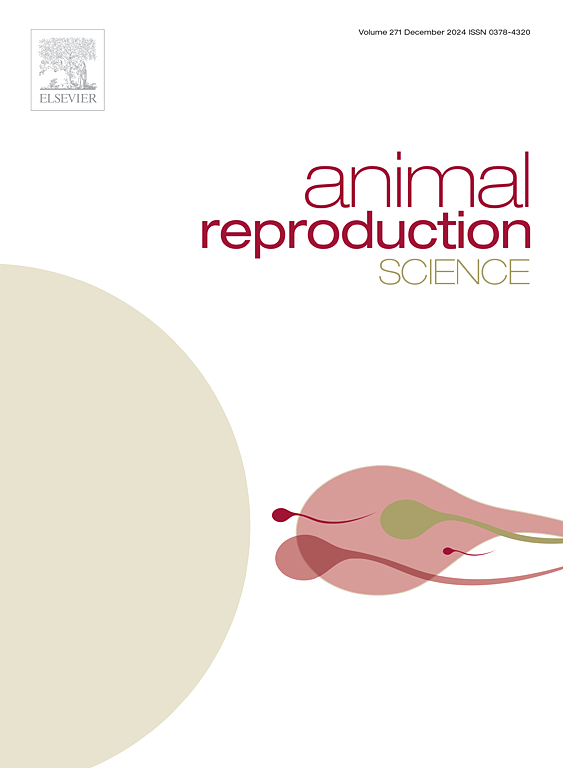由于进行性运动和受孕成功,种马精液中的精浆MicroRNA动力学
IF 3.3
2区 农林科学
Q1 AGRICULTURE, DAIRY & ANIMAL SCIENCE
引用次数: 0
摘要
本研究旨在探讨种马精浆中miR-34b、miR-122、let-7a的表达模式与进行性和受孕成功的关系,并评估其作为生物标志物的潜力。15匹成年种马被纳入研究。精浆1 ml保存在−80℃,每匹马取2 ml新鲜精液进行精子分析,其余仅用于1匹母马的人工授精。分为高进行性运动(HPM)组;n:8)和低进行性运动(LPM;N:7),基于进行性运动。根据第14天妊娠结果分为阳性妊娠组(n:8)和阴性妊娠组(n:7)。计算机辅助精液分析仪测定精液活力值和进行性活力值。采用流式细胞术检测精子活力、HMMP、PMAI、无能精子率和LPO参数。用qPCR方法评估microrna。还进行了靶标预测、蛋白相互作用和功能富集分析。总(82.13 ± 3.04;P <; 0.01)和进行性(45.88 ± 6.03;P <; 0.001),无能力精子率(45.76 ± 3.92;p <; 0.05)。与LPM相比,miR-34b (p <; 0.05)和miR-122 (p <; 0.05)在HPM中分别上调约11倍和6倍。miR-34b与总运动性呈正相关(0.674;p & lt; 0.01)。靶基因分析显示,该网络由102个基因和421个边组成。此外,还确定了涉及19种蛋白质的重要相互作用网络。富集分析显示所选的mirna显著调节关键通路。精浆中miR-34b和miR-122的调控差异可能决定了种马精液的特征。本文章由计算机程序翻译,如有差异,请以英文原文为准。
Seminal plasma MicroRNA dynamics in stallion semen due to progressive motility and conception success
This study aims to investigate the expression patterns of miR-34b, miR-122, let-7a in seminal plasma of stallions in relation to progressive motility and conception success, and to evaluate their potential as biomarkers. Fifteen adult stallions were enrolled in study. One ml of seminal plasma was kept at −80 °C, 2 ml of fresh semen was sampled from each stallion for sperm analysis, and the rest were used for artificial insemination only for one mare. Two groups were formed as high progressive motility (HPM; n:8) and low progressive motility (LPM; n:7), based on progressive motility. Besides, two groups were formed as positive (n:8) and negative (n:7) pregnancy groups according to 14th day pregnancy results. Motility and progressive motility values determined by computer-assisted semen analyzer. Flow cytometry was used to evaluate the viability, HMMP, PMAI, non-capacitated sperm rate and LPO parameters. MicroRNAs were evaluated with qPCR. Prediction of targets, protein-protein interactions and functional enrichment analyses were also performed. Total (82.13 ± 3.04; p < 0.01) and progressive (45.88 ± 6.03; p < 0.001) motilities, and non-capacitated sperm rates (45.76 ± 3.92; p < 0.05) were greater in HPM. Compared to LPM, miR-34b (p < 0.05) and miR-122 (p < 0.05) were upregulated in HPM approximately 11- and 6-fold, respectively. miR-34b and total motility were positively correlated (0.674; p < 0.01). Target gene analysis revealed a network of 102 genes and 421 edges. Moreover, significant interaction networks involving 19 proteins were determined. Performed enrichment analysis showed selected miRNAs significantly regulate crucial pathways. Regulatory differences of miR-34b and miR-122 in seminal plasma might serve to determine the characteristics of stallion semen.
求助全文
通过发布文献求助,成功后即可免费获取论文全文。
去求助
来源期刊

Animal Reproduction Science
农林科学-奶制品与动物科学
CiteScore
4.50
自引率
9.10%
发文量
136
审稿时长
54 days
期刊介绍:
Animal Reproduction Science publishes results from studies relating to reproduction and fertility in animals. This includes both fundamental research and applied studies, including management practices that increase our understanding of the biology and manipulation of reproduction. Manuscripts should go into depth in the mechanisms involved in the research reported, rather than a give a mere description of findings. The focus is on animals that are useful to humans including food- and fibre-producing; companion/recreational; captive; and endangered species including zoo animals, but excluding laboratory animals unless the results of the study provide new information that impacts the basic understanding of the biology or manipulation of reproduction.
The journal''s scope includes the study of reproductive physiology and endocrinology, reproductive cycles, natural and artificial control of reproduction, preservation and use of gametes and embryos, pregnancy and parturition, infertility and sterility, diagnostic and therapeutic techniques.
The Editorial Board of Animal Reproduction Science has decided not to publish papers in which there is an exclusive examination of the in vitro development of oocytes and embryos; however, there will be consideration of papers that include in vitro studies where the source of the oocytes and/or development of the embryos beyond the blastocyst stage is part of the experimental design.
 求助内容:
求助内容: 应助结果提醒方式:
应助结果提醒方式:


